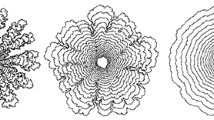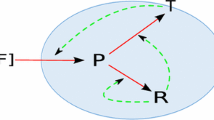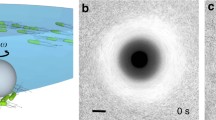Abstract
Patterned growth of bacteria created by interactions between the cells and moving gradients of nutrients and chemical buffers is observed frequently in laboratory experiments on agar pour plates. This has been investigated by several microbiologists and mathematicians usually focusing on some hysteretic mechanism, such as dependence of cell uptake kinetics on pH. We show here that a simpler mechanism, one based on cell torpor, can explain patterned growth. In particular, we suppose that the cell population comprises two subpopulations —one actively growing and the other inactive. Cells can switch between the two populations depending on the quality of their environment (nutrient availability, pH, etc.) We formulate here a model of this system, derive and analyze numerical schemes for solving it, and present several computer simulations of the system that illustrate various patterns formed. These compare favorably with observed experiments.
Similar content being viewed by others
References
Britton, N. E.: Reaction-Diffusion Equations and Their Applications to Biology. New York: Academic Press 1986
Chin, C., Hoppensteadt, F. C., Walkington, N.: Existence, uniqueness and numerical analysis of hysteretic reaction-diffusion systems (to be published)
Hoppensteadt, F. C., Jäger, W.: Pattern formation by bacteria. Lect. Notes Biomath. 38, 68–81 (1980)
Hoppensteadt, F. C.: Mathematical methods of population biology. Cambridge: Cambridge University Press 1982
Wimpenney, J. W. T., Coombs, J. P., Lovitt, R. W., Whittaker, S. G.: A gel-stabilized model ecosystem for investigation microbial growth in spatially ordered solute gradients. J. Gen. Microbiol. 127, 277–287 (1981)
Budriené, E. O., Polezhaev, A. A., Ptitsyn, M. O.: Mathematical modeling of intercellular regulation causing the formation of spatial structures in bacterial colonies. J. Theor. Biol. 135, 323–341 (1983)
Lewis, D. L., Gattie, D. K.: The ecology of quiescent microbes. ASM news 57, 27–32 (1991)
Gerhardt, P. et al.: Manual of Methods for General Bacteriology, Gerhardt, P. (ed). Washington: Am. Soc. for Microbiol. 1981
Lieberstein, H. M.: Theory of Partial Differential Equations. New York: Academic Press 1972
Monod, J.: Recherches sur La Croissance de Cultures Bacteriennes. Paris: Hermann 1942
Murray, J. D.: Mathematical Biology, Biomathematics Texts. Berlin, Heidelberg, New York: Springer 1989
Shehata, T. E., Marr, A. G.: Synchronous growth of enteric bacteria. J. Bacteriol., 103: 789 (1970)
Strikwerda, J. C.: Finite Difference Schemes and Partial Differential Equations. Belmont: Wadsworth 1989
Author information
Authors and Affiliations
Rights and permissions
About this article
Cite this article
Chiu, C., Hoppensteadt, F.C. & Jäger, W. Analysis and computer simulation of accretion patterns in bacterial cultures. J. Math. Biol. 32, 841–855 (1994). https://doi.org/10.1007/BF00168801
Received:
Revised:
Issue Date:
DOI: https://doi.org/10.1007/BF00168801




